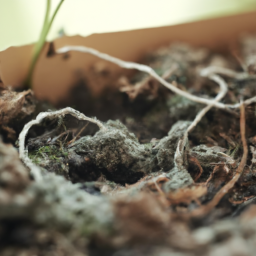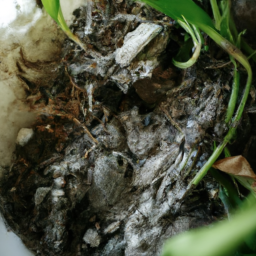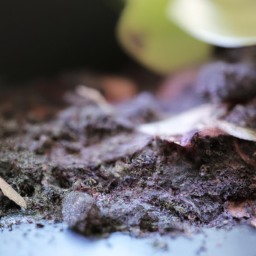
Hey there plant lovers! If you’re like me and enjoy having a lush indoor garden, you may have encountered a pesky problem: indoor plants with moldy soil. It can be frustrating to see your beloved green friends suffering, but fear not! In this blog post, we’ll delve into the causes of indoor plants developing moldy soil and explore effective ways to prevent and treat this common issue. So grab a cup of tea, sit back, and let’s dive into the world of indoor plants and their moldy soil woes!
Causes of Moldy Soil in Indoor Plants
Introduction
Indoor plants are a great way to bring nature into our homes and create a peaceful and inviting atmosphere. However, sometimes we may encounter issues with moldy soil, which not only affects the health and appearance of our plants but can also pose a risk to our own well-being. In this guide, we will explore the causes of moldy soil in indoor plants and provide you with step-by-step solutions to tackle this problem effectively.
Understanding Moldy Soil
Moldy soil is a common issue that many indoor plant enthusiasts face. It occurs when fungi, such as mold, grow in the soil, leading to a fuzzy or slimy appearance on the surface. This can be a result of several factors, including excessive moisture, poor drainage, lack of airflow, or even contaminated potting mix. It is crucial to address this issue promptly as moldy soil can hinder the growth of your plants and potentially spread harmful spores in your living space.
Identifying the Causes
1. Excessive Moisture: Overwatering is one of the primary causes of moldy soil. When we water our indoor plants too frequently or in excessive amounts, the soil becomes waterlogged, creating a perfect environment for mold to thrive. It is essential to understand the watering needs of each plant species and provide them with adequate moisture accordingly.
2. Poor Drainage: If your plant pots lack proper drainage holes or are not using well-draining soil, excess water will accumulate at the bottom, leading to mold growth. Ensure that your pots have sufficient drainage holes and use a quality potting mix that allows water to flow freely through the soil.
3. Lack of Airflow: Stagnant air around your indoor plants can contribute to moldy soil. Poor airflow prevents the soil from drying out, creating a damp environment that favors mold growth. Placing your plants in well-ventilated areas or using fans to enhance air circulation can help prevent mold formation.
4. Contaminated Potting Mix: Sometimes, mold spores can already be present in the potting mix you use for your indoor plants. This can occur if the mix is not properly sterilized or if it has been exposed to moisture for an extended period. It is advisable to choose high-quality potting mixes from reputable sources to minimize the risk of introducing mold spores into your plants’ environment.
Solutions to Combat Moldy Soil
1. Adjust Watering Practices: To prevent moldy soil caused by excessive moisture, ensure you water your indoor plants only when the top inch of soil feels dry. Use your finger to check the moisture level before watering. Additionally, avoid leaving standing water in saucers or trays after watering to prevent waterlogging.
2. Improve Drainage: If your plant pots lack drainage holes, consider repotting them into containers that do. Additionally, you can add a layer of small rocks or pebbles at the bottom of the pot to enhance drainage. Using well-draining potting mix that consists of a combination of perlite, vermiculite, or sand can also help prevent water accumulation.
3. Enhance Air Circulation: Ensure that your indoor plants are placed in areas with adequate airflow. Avoid crowding them together, as this can restrict air movement. If necessary, use fans to promote air circulation around your plants. Opening windows or using dehumidifiers can also help reduce excess moisture in the air.
4. Replace Potting Mix: If you suspect that the potting mix is contaminated with mold spores, consider repotting your plants using fresh, sterilized potting mix. Gently remove the plant from its current pot, shake off the old soil, and replant it in a clean container with new soil. This will help eliminate any existing mold spores and provide a fresh start for your plants.
5. Monitor Humidity Levels: Mold thrives in high humidity environments. Use a hygrometer to measure the humidity levels in your home, especially around your indoor plants. If the humidity is consistently high, consider using a dehumidifier to reduce moisture in the air.
Conclusion:
Moldy soil in indoor plants can be a frustrating problem, but by understanding its causes and implementing these step-by-step solutions, you can effectively combat it. Remember to adjust your watering practices, improve drainage, enhance air circulation, and monitor humidity levels to create a healthy environment for your beloved indoor plants. With proper care and attention, you can enjoy the beauty and benefits of indoor plants without the worry of moldy soil.

Prevention and Treatment of Moldy Soil in Indoor Plants
Indoor plants are a great way to bring nature into your home and create a peaceful and refreshing environment. However, one common issue that many indoor plant owners face is moldy soil. Mold growth in the soil can not only be unsightly but also harmful to the health of your plants. In this article, we will discuss the prevention and treatment of moldy soil in indoor plants, ensuring your plants thrive in a healthy environment.
Understanding the Causes of Moldy Soil
Moldy soil is primarily caused by excessive moisture and poor drainage. When the soil remains consistently wet, it creates the perfect breeding ground for mold spores to grow and thrive. Overwatering, using pots without drainage holes, or placing plants in areas with poor air circulation can contribute to the development of mold in the soil. Additionally, using contaminated soil or reusing old soil can introduce mold spores into your indoor plants’ environment.
To prevent moldy soil, it is crucial to understand and address these underlying causes. By taking proactive measures, you can ensure a healthy growing environment for your indoor plants.
Preventive Measures
1. Proper Watering: The key to preventing moldy soil is to maintain proper watering practices. Different plants have different water requirements, so it is essential to research and understand the specific needs of your indoor plants. Avoid overwatering by allowing the top inch of soil to dry out before watering again. Use your finger or a moisture meter to check the moisture level in the soil.
2. Adequate Drainage: Ensure that your pots have drainage holes to allow excess water to escape. This helps prevent waterlogging and allows the soil to dry out between watering sessions. If you have decorative pots without drainage holes, consider using a plastic liner or placing the plant in a separate pot with drainage and then placing it inside the decorative pot.
3. Improve Air Circulation: Good air circulation is crucial for preventing mold growth. Avoid placing indoor plants in areas with stagnant air, such as corners or tight spaces. Instead, position them near windows or use fans to promote air movement. This will help dry out the soil faster and discourage mold growth.
Treating Moldy Soil
1. Identify the Mold: Before treating moldy soil, it is essential to identify the type of mold present. There are various types of mold, including white mold, black mold, and green mold. While most molds are harmless to humans, they can still affect the health of your plants. If you are unsure about the type of mold, it is best to consult a professional or a local nursery.
2. Remove Moldy Soil: If you notice mold growth on the soil surface, it is crucial to act promptly. Carefully remove the affected soil using a spoon or a small garden trowel. Be gentle to avoid damaging the plant’s roots. Dispose of the moldy soil in a sealed bag to prevent the spores from spreading.
3. Sterilize the Pot: Once the moldy soil is removed, it is essential to sterilize the pot to eliminate any remaining mold spores. Wash the pot with a mild bleach solution or use a commercial disinfectant specifically designed for plant pots. Rinse the pot thoroughly before repotting your plant.
4. Repotting: After removing the moldy soil and sterilizing the pot, repot your plant in fresh, well-draining soil. Use a high-quality potting mix that is suitable for your specific type of indoor plant. This will provide a healthy growing medium and reduce the risk of mold growth in the future.
5. Adjust Watering Routine: Once your plant is repotted, reassess your watering routine. Ensure you are following the proper watering guidelines for your specific plant species. Avoid overwatering and allow the soil to dry out slightly between watering sessions. This will help prevent the recurrence of moldy soil.
By following these preventive measures and taking the necessary steps to treat moldy soil, you can provide a healthy and thriving environment for your indoor plants. Regularly monitor your plants for any signs of mold growth and address the issue promptly to ensure the longevity and beauty of your indoor greenery.

Best Practices for Maintaining Healthy Soil in Indoor Plants
Indoor plants not only add beauty and freshness to our living spaces but also provide numerous health benefits. However, one common issue that plant owners often face is moldy soil. Moldy soil can lead to various problems, including stunted growth, root rot, and even the death of your beloved plants. In this article, we will discuss the best practices for maintaining healthy soil in indoor plants, ensuring their longevity and vitality.
Understanding the Causes of Moldy Soil
Before diving into the best practices for maintaining healthy soil, it is essential to understand the causes of moldy soil. Mold growth in indoor plants is primarily caused by excessive moisture and poor drainage. Overwatering, inadequate airflow, and high humidity levels create the perfect environment for mold and fungi to thrive. Additionally, using contaminated soil or reusing old soil can introduce mold spores into your plant’s environment.
To prevent moldy soil, it is crucial to address these underlying causes. Let’s explore some effective best practices:
1. Proper Watering Techniques
Watering is a fundamental aspect of plant care, and mastering proper watering techniques can significantly contribute to maintaining healthy soil. Here are some tips:
A. Watering Frequency: Different plants have different water requirements. It is essential to research and understand the specific watering needs of your indoor plants. Overwatering can lead to waterlogged soil, which promotes mold growth. Underwatering, on the other hand, can result in dry soil, making it difficult for plants to absorb nutrients properly. Find the right balance and water your plants accordingly.
B. Watering Methods: Avoid pouring water directly onto the soil surface. Instead, water the plants at the base, near the roots. This helps prevent excess moisture on the soil surface, reducing the risk of mold growth. Additionally, using a watering can or a spray bottle with a narrow nozzle allows for precise watering and prevents water splashing.
C. Drainage: Ensure that your plant pots have proper drainage holes. These holes allow excess water to escape, preventing water from accumulating at the bottom of the pot. Standing water can lead to mold growth and root rot. If your pots don’t have drainage holes, consider repotting your plants into pots that do.
2. Adequate Air Circulation
Adequate air circulation is crucial for preventing mold growth in indoor plants. Stagnant air promotes moisture buildup, creating a favorable environment for mold and fungi. Here are some tips to improve air circulation:
A. Positioning: Avoid placing your plants in areas with poor airflow, such as corners or tight spaces. Instead, position them in areas where there is natural air movement, such as near windows or fans. This allows for better ventilation and helps keep the soil dry.
B. Use Fans: Consider using small fans to improve air circulation around your plants. Gentle airflow not only dries out the soil faster but also strengthens the plant’s stems and leaves. However, make sure the fan is not blowing directly onto the plants, as it can cause damage.
C. Open Windows: Opening windows periodically, especially during dry and sunny days, can help remove excess moisture from the indoor environment. Fresh air circulation is beneficial for both your plants and your overall indoor air quality.
3. Proper Soil Management
Proper soil management is essential for maintaining healthy soil in indoor plants. Here are some key practices:
A. Quality Soil: Start with high-quality potting soil that is well-draining and specifically formulated for indoor plants. Avoid using garden soil, as it tends to retain more moisture and can lead to mold growth.
B. Regular Inspections: Regularly inspect your plants’ soil for any signs of mold, mildew, or fungus. If you notice any, remove the affected soil immediately and replace it with fresh, sterile soil. Prompt action can prevent the spread of mold to the rest of the plant.
C. Avoid Overcrowding: Overcrowding plants in a single pot can lead to increased moisture retention and poor airflow. Ensure that each plant has sufficient space to grow and thrive. If necessary, repot your plants into larger containers.
By following these best practices, you can significantly reduce the risk of moldy soil in your indoor plants. Remember, prevention is key when it comes to maintaining healthy soil. Regularly monitor your plants, provide them with the right amount of water, and create a well-ventilated environment. With proper care, your indoor plants will flourish and bring joy to your home for years to come.
I’ll leave you with these final thoughts
If you’ve noticed a strange, musty smell in your home or office, it could be due to moldy soil from your indoor plants. While indoor plants are a great way to bring nature indoors and add a touch of greenery to your space, they can also create the perfect environment for mold to thrive. Moldy soil can not only be unpleasant to smell, but it can also be harmful to your health if left unchecked. In this blog post, we’ll explore why indoor plant soil gets moldy and what you can do to prevent and treat this issue.
Moldy soil is often caused by overwatering or poor drainage. When we water our plants too frequently or don’t provide adequate drainage, the soil becomes excessively moist, creating the ideal conditions for mold growth. Additionally, the organic matter in the soil provides a food source for mold, allowing it to multiply quickly. To prevent moldy soil, it’s important to water your plants only when necessary and ensure that the pots have proper drainage holes. If you notice mold on the surface of the soil, it’s crucial to address the issue promptly to prevent it from spreading. We’ll discuss effective ways to treat moldy soil, such as removing the affected soil, improving ventilation, and using natural remedies like cinnamon or hydrogen peroxide. By taking proactive measures, you can keep your indoor plants healthy and mold-free, creating a pleasant and fresh environment in your space.
Frequently Asked Questions (FAQ):
Q1: Why is my indoor plant’s soil getting moldy?
A1: Moldy soil in indoor plants can be caused by several factors. One common reason is overwatering, which creates a damp environment ideal for mold growth. Poor drainage, lack of sunlight, and high humidity levels can also contribute to moldy soil. Additionally, using contaminated potting soil or not properly sterilizing gardening tools can introduce mold spores to the soil.
Q2: How can I prevent mold from growing in my indoor plant’s soil?
A2: To prevent mold growth in your indoor plant’s soil, it’s important to maintain proper watering practices. Only water your plants when the top inch of soil feels dry, and ensure that the pots have drainage holes to allow excess water to escape. Providing adequate sunlight and good air circulation can also help prevent mold. Additionally, using sterilized potting soil and regularly cleaning your gardening tools can minimize the risk of introducing mold spores to the soil.
Q3: Is moldy soil harmful to my indoor plants?
A3: Moldy soil can be harmful to indoor plants if left untreated. Mold can hinder the plant’s ability to absorb nutrients and water, leading to stunted growth or even plant death. It can also cause root rot, which further weakens the plant. Moreover, certain molds can release spores that may trigger allergies or respiratory issues in humans and pets. Therefore, it’s crucial to address moldy soil promptly to ensure the health of both your plants and yourself.
Q4: How can I get rid of mold in my indoor plant’s soil?
A4: To get rid of mold in your indoor plant’s soil, start by removing any visible mold growth on the soil surface. Gently scrape off the moldy layer and dispose of it. Next, allow the soil to dry out by adjusting your watering schedule. If the mold problem persists, you can try repotting the plant using fresh, sterilized potting soil. Additionally, improving ventilation and reducing humidity levels in the room can help prevent mold recurrence.
Q5: Can I reuse the soil after removing mold from my indoor plant?
A5: It’s generally recommended not to reuse soil that has had a mold problem. Mold spores can be difficult to completely eliminate, and there is a risk of recontamination. Reusing moldy soil may reintroduce the mold to your plants, leading to recurring issues. It’s best to discard the moldy soil and start fresh with sterilized potting soil to ensure the health of your indoor plants.

James Wong is a renowned ethnobotanist, plant scientist, and local television presenter. With a passion for demystifying plant science, he is known for translating complex botanical concepts into practical advice for everyday plant enthusiasts. James’s expertise spans from traditional gardening to cutting-edge plant technologies, making his insights accessible and informative.


